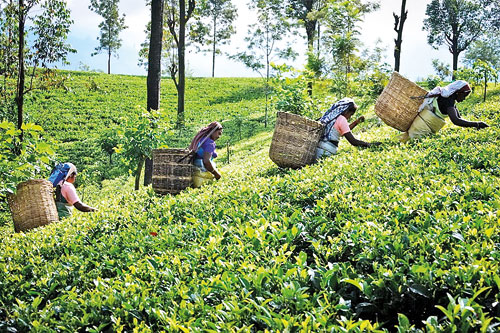1% of GDP of Colombo Metro area lost due to floods

Tea slopes with trees in the background
As attention turns to how ill-prepared Sri Lanka was yet again, for the previously benign monsoon, curbing deforestation is often cited as a way in which we can prevent the escalation of impacts of increasingly common natural disasters. As we discuss reforestation efforts in order to combat carbon emissions and increase resilience to natural disasters, it is important that the complex range of benefits provided by forests are understood. In addition to preventing landslides and reducing flood risk, forests play a crucial role in sustaining cash crops, in particular the tea industry.
Historically, tea plantations were responsible for the clearing of vast swathes of primary forest in the hill country under British rule. Despite falling commodity prices, forest land is still converted to agricultural land for cash crops, and encroachment on to protected forest reserves by smallholder tea plantations is responsible for the steady erosion of forested land in Sri Lanka.
While tea accounts for the highest revenue earned from agricultural exports, the industry has declined in the last few years, constricted by low global commodity prices and low yields when compared to Kenyan and Indian competitors. As the industry attempts to restate and rework its relevance, it is vital that strategies of expansion and growth do not sacrifice forests.
The industry hinges on the existence of healthy forest ecosystems that provide unvalued and unaccounted services that both enable tea cultivation and enhance crop yield. Ecosystems such as forests and wetlands can be considered natural capital whose biophysical processes result in a range of benefits termed “ecosystem services”. These services have a tangible value that can be estimated and represented in monetary terms. For instance, a wetland that offers natural flood protection could be represented by the cost of artificial flood defence schemes needed in its absence, or property damage and cleanup costs of the floods it could have mitigated. Considering that 1 per cent of the GDP of the Colombo Metropolitan area is lost each year due to floods, the economic value provided by wetlands must be visible and recognised.
The precise climate which tea thrives in with constant moisture, soil temperature between 16- 25C and air temperature between 10-20C, is maintained by adjacent forest. In Kenya two-thirds of tea is grown near forests, while even in Sri Lanka, plantations are found in close proximity to forests. Studies conducted in Kenya and Burundi found that forests regulate temperature and rainfall, and as windbreaks, thus fostering the ideal environment for tea. Apart from this, forests also boost the productivity of nearby tea estates as root systems stabilise soil and create ideal conditions for nutrient recycling in the soil. Nutrient fixation can reduce the need for chemical inputs and labour costs. Biodiversity sustained by healthy forests also provides organic pest control, further reducing the need for agrochemicals and offering the branding possibility of organic tea.
A study conducted by the Environmental Foundation Ltd to explore connection between forests and tea estates and gauge the plantation managers’ understanding of this relationship found that over 80 per cent of the 84 estates which were covered in the study were situated next to a forest.
Majority of the respondents acknowledged the vital role that forests played in maintaining tea yields, even though most had not undertaken any attempt to study or quantify this contribution, citing microclimate regulation and soil fertility as the salient benefits of adjacent forests. One respondent even went as far to say that the “industry would collapse” without forests.
All estate managers surveyed, indicated that they were willing to make a financial commitment to protecting forest ecosystem services, with existing actions including the conversion of bare land to forest plantations, gaining Forest Stewardship Council Certification and protecting forest borders.
Further research that quantifies ecosystem services provided by forests and valuations of forests in terms of erosion control, carbon sequestration and pest control to prove benefits. Investors and shareholders need to start viewing forests as natural capital that must be managed effectively in order to minimise risk and maximise provide, encouraging reforestation of barren tea lands and along watercourses. Payments for ecosystem services are one such method where estates can enlist communities to protect forests. Given that forests are the invisible linchpin on which the tea industry rests, we need a perceptional shift from viewing these benefits as vague and intangible to recognising them as quantifiable facts that can influence profit margins and create a competitive edge. As the effects of climate change loom ahead, forests are no longer expendable. (The writer is a member of the Environmental Foundation Ltd)


